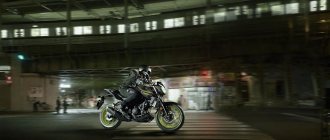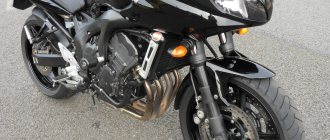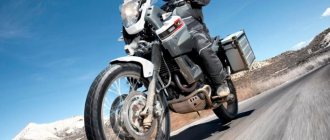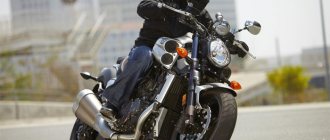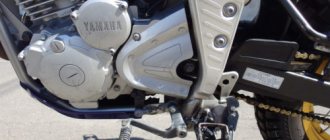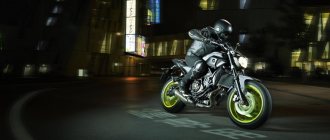Yamaha FZ6 (FZ6N, FZ6S, FZ6R) motorcycle review
Injector, six-speed, aluminum frame, derated R6 engine, not an embryonic fit. the landing is a minus, probably on the track, but on Russian asphalt potholes you can see better, you get less tired. How tired you get there - you go and relax!
Suspension.
Only the rear preload is adjustable. More than enough for the first moto. Everything is counted up to Us! He grabs all the bumps so much that he calmly catches up with the skaters, who, having 800 cubic meters on flat straights, naturally leave. Would you say it's a gasket issue? No, I also regret my waste. It’s just lighter, the suspension travel is 130mm, it’s enough for him. No, I’m not trying to fully compare it with the VFR, it’s cooler. Don’t strain your ferroducts.
Motor.
Well, at low levels he is gentle and affectionate. Up to 6 thousand predicted smooth traction, just right for a beginner. C6.5, a certain vibration appears, does not bother the thighs much, but the traction gradually increases, around 8 thousand the vibration disappears, in return giving maximum acceleration, growing to 12 tons. about.! Some compare this acceleration to a good kick. For me, this is not the case in all cases, but in 1st, 2nd, and 3rd gears for sure.
Box.
Well, yes, like the bolt of a rifle. Loud. Well, I think the main thing is not to doubt it. Pull sharply, clearly, and it will recharge as it should! Moreover, the volume of switching on Yamaha devices does not affect reliability.
Motor box.
The transmissions are very long and heavily overlapped. There are 6 of them. The first one will easily score a hundred. The sixth one will not choke and will spin smoothly but confidently from 30!
Appearance.
He's handsome. Almost perfect. There are a bunch of mots near the cafe, Siberian F4, 3 ferra from different years, VTR, something else, and 2 phasers. Passers-by turn their heads...at the phasers. Damn, I’m not bragging, I have a 2005 phaser s, my friend has a 2007 s2, it’s even more beautiful, the spendthrift is not for showing off, but bitch, he’s handsome! Something like this.
Flaws.
Yes, there are them too. Due to the vertical landing, long suspension travel, and lack of adjustment, the lane loading. The forks are underpowered in tight corners on rough roads, causing some hesitation when cornering at speed. But this is a price to pay for comfort on a straight line.
I forgot about the brakes. Fz6 s-s2 with abs are very decent. My fz6s is somewhere around a four.
He drives quite quickly - he made big black jeeps from a traffic light, without really understanding how to start. On the other hand, the power curve is flat - as much as you unscrew, you will go as far as you can.
Relatively inexpensive. Lots of spare parts and information on how to fix things. The previous owner drove it 30k, only filling the tank with gas and changing the tires.
Looks smart. The prices for plastic are also quite reasonable. I accelerated to a maximum of 233, and up to 200 it basically goes briskly. It pulls in any gear, although after the season I developed the habit of clicking down one when overtaking.
Comfortable seating, I drove 200 km on a mini-long distance trip and didn’t notice that I had passed. It consumes about a tank for 200 km if you crank it all the way. To overtake the worst stuff in 4th - I changed lanes at 70 mph, unscrewed, when I overtook, the speedometer already showed 160)) full of emotions)))
The downside is that the stock windshield needs to be replaced if you drive more than 150. Expensive mufflers, since there are two of them (the cheapest straight-through costs about 600 greenbacks without delivery). Sometimes the box stalls when switching from 1 to 2 (neutral blinks several times and there is a chance of staying in neutral and not 2nd). It's hard to shift at rpms above 8k. I asked my brother - everything is exactly the same with him.
They say that Yamahas tend to burn oil - my phaser does not have this habit.
The Yamaha FZ6-S2 bike is soft and kind on the outside, but is angry and biting if you tease it a little. Of course, Yamaha designers could have simply upgraded the already good FZ400 motorcycle, but the company went much further. The bike was developed from scratch based on a derated engine from the Yamaha R6 sportbike.
It handles perfectly, while skillfully hiding its 187 kg dry weight. It reacts to opening the throttle with almost no delay. New notes appear only when the rpm increases beyond 8000. A dashing sharpness appears when the given trajectory is very accurately followed. The gears are engaged very accurately, without a characteristic click. True, the gearbox ratios have been slightly spread out (compared to the R6), which made it possible to work less with the shift lever, and, consequently, added comfort. In general, the movement is very comfortable. Minimum attention to the controls, maximum to the road situation.
It has a short wheelbase and fairly torsionally rigid suspensions that allow you to control the bike
eyebrow movement
.
The narrow one-piece handlebars, mounted on high spacers on the top crossbar, make it possible to flow
past heavy traffic where many other motorcycles pass.
He inherited a solid front fork with 43 mm feathers from the liter
Fazer.
A rectangular profile pendulum resting on a single shock absorber is a design that, although not new, is quite logical and time-tested. All the buttons and levers are at your fingertips, the compact but informative dashboard is in place, good visibility in the mirrors (which can be folded in front of the traffic jam, although I have never done this, and so “traffic traffic” is at the highest level). After a quick start of the injection engine, a minute warm-up and start. Comfortable seating position with a slight forward lean that does not require getting used to, narrow handlebars that allow you to pass where other motorcycles stop. The engine pleases with smooth traction from the bottom and an explosion after 8000 rpm. There are plenty of brakes for dynamic driving around the city. The suspension gets the job done with or without a passenger. The motorcycle is ideal for dynamic driving around the city and for long-distance driving. Thanks to the short wheelbase, maneuverability is like that of a four hundred. The design of the motorcycle attracts the eyes of others. On wide 180 tires the motorcycle is stable on straights and in turns. During long-term driving up to 140 km/h, the upper fairing copes well with the oncoming air flow.
Nowadays, motorcycle manufacturers, as if to order, build precisely such devices that the public simply cannot help but like. But you won’t go far on an attractive appearance alone and you won’t earn a good reputation - you need technical support. From this point of view, Yamaha coped with this task quite well. An excellent chassis, coupled with decent brakes and a powerful engine, fulfills its assigned tasks.
Great
.
Due to the classic seating position and high handlebars, the bike is very easy to control at low speeds. This circumstance makes moving around the city a great pleasure. At high speeds the behavior of the motorcycle is quite adequate. In normal modes, the motorcycle does not provoke aggressive riding, but as soon as you push the tachometer needle above 8 thousand rpm, you immediately remember its relationship with the R-6 sport and understand what it is capable of. The motorcycle is very good for use in any mode and for any mood. With its average fuel consumption in Moscow being 4-5.5. l/100 km is an excellent means of transportation, and if you are also friends, then driving turns into an outright thrill. A very calm and friendly motorcycle. Steers easily and effortlessly. No provocation for fast, reckless driving. You sit up straight, you don’t have to stretch anywhere, you don’t have to lie down on the tank, at least up to 200 km/h you rode on outstretched arms! (cruising speed is 130-160 IMHO) there are no problems with the bike. At the beginning of this season, I took it to the service center and asked that everything be replaced, including spark plugs, hoses with reinforced ones, in short, a complete service. The price of the issue is 18,000 rubles with spare parts (I’m sure it can be done cheaper, but due to my ignorance I drove it to Promoto and ordered everything there). I go to work almost every day, I really like it! I didn’t go long distance, maximum 400 km per day. No questions about fatigue, pain in the hands, etc. I’m selling now, I want an FJR 1300 and my wife and I are going to Europe! It’s difficult for two people to drive the 600, it’s designed for one.
Chassis and brakes
A characteristic feature of the FZ6 is that the front and rear suspension travel is the same and amounts to 130 mm. This is neither too much nor too little, but considering the class, it’s just right. A pair of brake discs at the front and one at the rear fully provide the model with the necessary braking potential; fortunately, Yamaha did not skimp and install a drum brake in the rear.
Apparently, to facilitate the design, the frame here is made of aluminum. However, the weight of about 200 kg, even with fuel, is a sufficient justification for such measures, because, after all, this is a typical naked bike, and not some kind of sports tourer or hybrid.
Power point
For the lightweight Yamaha XJ6 motorcycle, the characteristics of the upgraded engine are perfectly suited.
The displacement of the four-stroke in-line four-cylinder liquid-cooled engine is 600 cc. The unit develops a maximum power of 78 hp. (57 kW) at 10 thousand rpm, and the maximum torque is 59.7 Nm at 8.5 thousand rpm.
The cylinders are inclined forward, each of them has four valves, camshafts, and there are two of them, overhead. The newly designed cylinder head allows for a higher compression ratio. Intake ports have been reduced. To increase rigidity, the upper half of the crankcase is made as a single unit with the cylinder block.
The camshaft cam profile is designed to provide high torque at low and medium crankshaft speeds.
To reduce the weight of the motorcycle, the pistons are forged aluminum.
The fuel injection system has dual-directional four-port fuel injectors.
The muffler of the exhaust system, the configuration of which is “4-1”, is located under the frame. It is equipped with an oxygen sensor and a three-way catalytic converter.
And this is not all the features of the engine system of the Yamaha XJ6 motorcycle.
Test drives and reviews of the motorcycle
Experienced pilots confirm that the operating speed range is quite wide; in city traffic, you can not change gears frequently and still accelerate intensively.
The engine starts with a typical muffled, low sound. Motorcyclists consider this an element of passive safety, because the XJ6 will not go unnoticed by surrounding motorists. It starts easily, starting almost at idle speed.
Pilots also like the effective braking system, especially with the ABS system, and the balanced suspension. The motorcycle easily takes the sharpest turns and overcomes road unevenness.
Reviews about the Yamaha XJ6 (almost all, at least from those motorcyclists who have something to compare with) agree that this is a city motorcycle. It is maneuverable, easy to control, even the wider rear tire helps with this, but it is not comfortable enough for travel.
Experienced bikers lack character in this motorcycle, but for beginners this behavior of the machine is a great advantage.
Yamaha XJ6 is an honest motorcycle. What it costs is what it provides: simplicity and cost-effectiveness of maintenance, unpretentiousness, responsiveness, versatility, truly Japanese reliability and the absence of design flaws. As a bonus, there is a stylish and modern design that looks more expensive than it actually is. And even though it may seem overly predictable and calm to spoiled pilots, beginners feel more confident on it, and this is worth a lot.
Specifications
| KAWASAKI ER-6F (2010) | YAMAHA XJ6 DIVERSION (2010) | |
| PRICE | $9000 | $11800 (NEW IN SHOWROOM) |
| BUY | USED MARKET | WWW.YAMAHA.UA |
| ENGINE | ||
| POWER | 71 HP AT 8500 RPM | 76 HP AT 10000 RPM |
| TORQUE | 66 NM AT 7000 RPM | 60 NM AT 8000 RPM |
| TYPE | 649 CM3, P2, 8V, DOHC, F | 600 CM3, P4, 16V, DOHC, F |
| DIAMETER X STROKE | 83 X 60 MM | 65.5 X 44.5 MM |
| COMPRESSION RATIO | 11,3:1 | 12,2:1 |
| SUPPLY SYSTEM | INJECTOR, 38MM THROTTLE VALVE | INJECTOR |
| CLUTCH | MULTI-DISC IN OIL BATH | MULTI-DISC IN OIL BATH |
| TRANSMISSION | 6-SPEED, CHAIN | 6-SPEED, CHAIN |
| CHASSIS | ||
| FRAME | DIAGONAL STEEL | DIAGONAL STEEL |
| FORK RACE ANGLE/STAY | 25° / 106 MM | 26° / 103 MM |
| FRONT SUSPENSION | 41MM CONVENTIONAL TELESCOPIC FORK, NON-ADJUSTABLE, 120MM TRAVEL | 41MM CONVENTIONAL TELESCOPIC FORK, NON-ADJUSTABLE, 130MM TRAVEL |
| REAR | STEEL PENDULUM, MONO-SHOCK ABSORBER, SPRING PRESET ADJUSTMENT, 125 MM STROKE | STEEL PENDULUM, MONO-SHOCK ABSORBER, SPRING PRESET ADJUSTMENT, 130 MM STROKE |
| FRONT BRAKES | 2X300 MM DISCS, 2-PORSH. CALIPERS | 2X298 MM DISCS, 2-PORSH. CALIPERS |
| REAR | 220 MM DISCS, 1-PORSH. CALIPER | 245 MM DISC, 1-PORSH. CALIPER |
| FRONT TIRE | 120/70 R17 | 120/70 R17 |
| REAR | 160/60 R17 | 160/60 R17 |
| DIMENSIONS | ||
| WHEELBASE | 1410 MM | 1440 MM |
| SEAT HEIGHT | 790 MM | 785 MM |
| CLEARANCE | 145 MM | 140 MM |
| TANK | 15.5 L | 17.3 L |
| CURRENT WEIGHT | 204 KG | 211 KG |
Advantages of a motorcycle
The compact Yamaha XJ6 motorcycle is simple and easy to ride. It perfectly combines handling and high performance.
The motorcycle is equipped with an engine with high torque already at low and medium shaft speeds.
The designers, by installing an adjustable steering wheel and a low saddle, allowed an adult driver of any height to choose an ergonomic, comfortable fit. True, reviews from motorcyclists closer to 190 cm tall and weighing 90 kg dampen such optimism. No settings or adjustments help them feel comfortable behind the wheel.
And not the least role in describing the advantages of the motorcycle is played by its stylish and beautiful appearance, which, combined with its low weight, makes the XJ6 attractive to the fair half of humanity.
Measurement results
| KAWASAKI ER-6F (2010) | YAMAHA XJ6 DIVERSION (2010) | |
| MAX. SHAFT POWER | 63.2 HP AT 8750 RPM | 65.7 HP AT 9250 RPM |
| MAX. POWER AT THE WHEEL | 69.3 HP AT 8750 RPM | 72.1 HP AT 9250 RPM |
| MAX. TORQUE ON SHAFT | 60 NM AT 7250 RPM | 53.3 NM AT 8250 RPM |
| MAX. TORQUE ON WHEEL | 64.5 NM AT 7250 RPM | 58.4 NM AT 8250 RPM |
| SPECIFIC SHAFT POWER | 106.7 HP/LITER | 120.2 HP/LITER |
| ACCELERATION | ||
| 0-100 M | 119.2 KM/H IN 5.165 S | 117.5 KM/H IN 5.253 S |
| 0-200 M | 148 KM/H IN 7.848 S | 144.9 KM/H IN 7.964 S |
| 0-300 M | 164.4 KM/H IN 10.144 S | 161.3 KM/H IN 10.293 S |
| 0-400 M | 176.6 KM/H IN 12.253 S | 172.7 KM/H IN 12.452 S |
| PERFORMANCE CHARACTERISTICS | ||
| MAX. SPEED | 207.1 km/h | 201.8 km/h |
| WEIGHT WITHOUT FUEL | 196.6 KG (98.4 FRONT; 98.2 REAR) | 202.2 KG (101.4 FRONT; 100.8 REAR) |
| FUEL CONSUMPTION IN THE CITY | 6.1 L/100 KM | 6.3 L/100 KM |
| IN THE COUNTRY | 5.7 L/100 KM | 5.9 L/100 KM |
| AT SPEED 130 KM/H | 5.9 L/100 KM | 6.2 L/100 KM |
“The ER-6f engine reaches peak power at 8500 rpm, however, from 7500 rpm the dynamics of horsepower growth drops. At higher operating modes, the Diversion engine is ahead of its competitor in power, but not in torque."
Taken from BIKE magazine No. 4/2010
